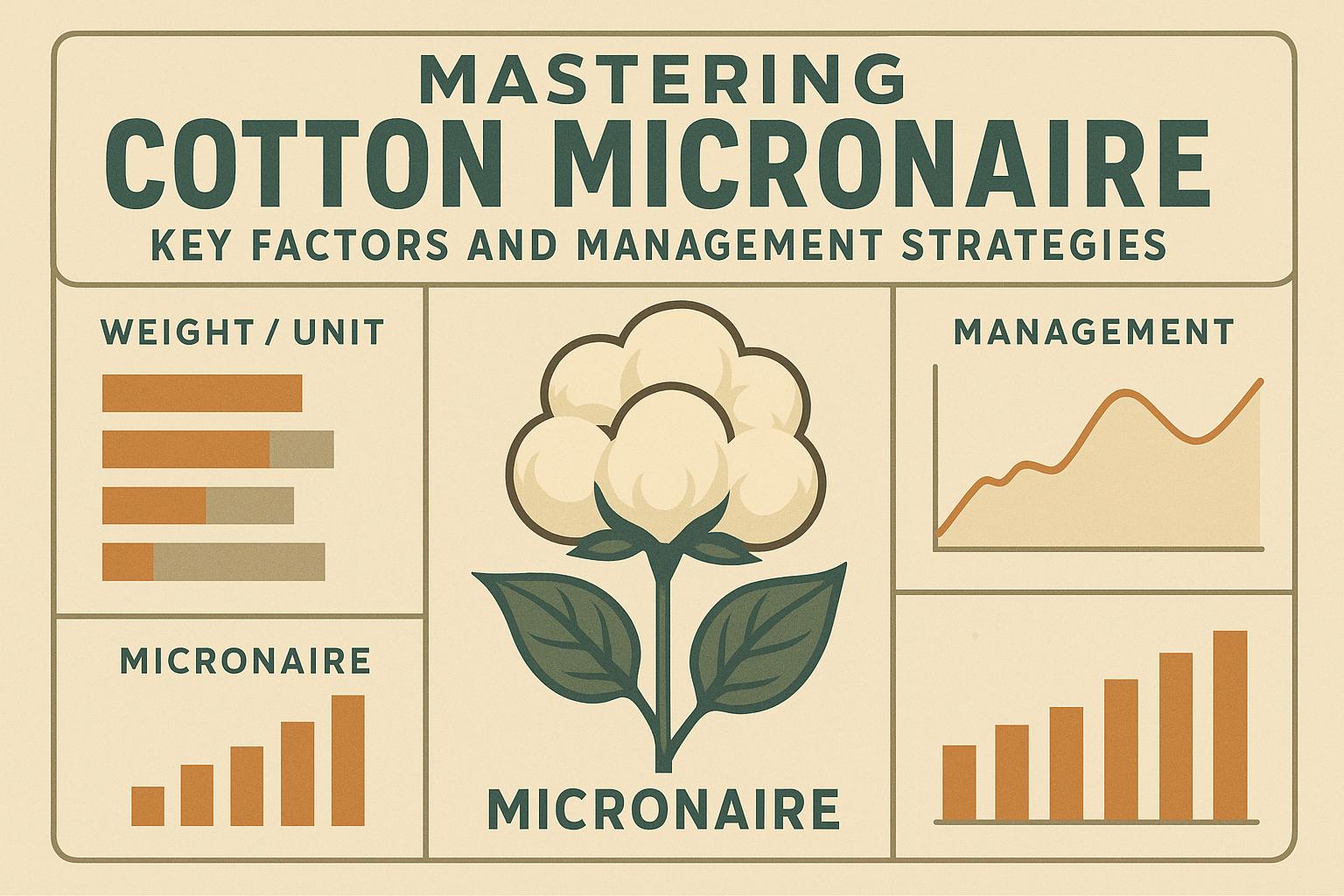The Importance of Fiber Quality in Modern Cotton Production
You've spent years honing your cotton operation, navigating everything from variable weather to input costs. But in today's market, where buyers demand premium lint for textiles and beyond, focusing on cotton fiber quality through agronomic practices can set your farm apart. It's not just about yield anymore; it's about producing fiber that spins better, dyes evenly, and commands higher prices. Poor fiber can lead to discounts, while superior traits like length, strength, and micronaire can boost your bottom line.
Research from extension services shows that targeted management can improve fiber uniformity by 5-10%, directly impacting gin turnout and market value. For seasoned growers, this means integrating proven strategies into your system without overhauling everything. We'll explore practical ways to enhance cotton fiber quality through agronomic practices, assuming you're well-versed in basics like scouting and rotation. These approaches draw on soil science, plant physiology, and real-world data to address common challenges.
If you're already optimizing nutrients, link this to our Nutrient Management Strategies for Cotton Farming: Maximizing Yield and Sustainability for a holistic view.
Soil Management: The Foundation for Superior Fiber
Strong cotton fiber starts below ground. Soil structure, pH, and organic matter directly influence root development, which in turn affects fiber elongation and maturity. In loamy soils typical of many cotton regions, maintaining a pH between 6.0 and 6.8 optimizes micronutrient availability, preventing issues like short staple length from zinc deficiencies.
- Deep Tillage for Root Penetration: Compacted soils restrict roots, leading to uneven fiber development. Use subsoilers every 2-3 years in high-traffic zones to break hardpans, allowing roots to access deeper moisture and nutrients. Data indicates this can increase fiber length by up to 1/32 inch in responsive fields.
- Organic Matter Building: Incorporate crop residues or cover crops to raise organic content above 2%. This improves water-holding capacity, reducing stress during boll fill that causes weak fibers. In trials, fields with higher organic matter showed 15% better fiber strength.
- Precision Soil Sampling: Grid sampling every 2.5 acres reveals variability, enabling variable-rate lime applications. Acidic patches can cause brittle fibers; correcting them ensures uniform maturity.
Avoid over-fertilization, as excess nitrogen promotes vegetative growth at the expense of fiber quality. Monitor with tissue tests during peak bloom to fine-tune applications.
For more on foundational health, see our Improving Soil Health in Cotton Farming: Essential Strategies for Long-Term Productivity.
Variety Selection: Matching Genetics to Your Environment
Choosing the right variety is a cornerstone of enhancing cotton fiber quality through agronomic practices. Modern cultivars offer traits like longer staples and higher strength, but success depends on matching them to your soil, climate, and pest pressures. For example, in humid areas prone to boll rot, select varieties with storm-proof bolls to protect fiber integrity.
- Evaluate Trial Data: Look beyond yield; prioritize gin turnout and fiber parameters from regional variety trials. Varieties with micronaire in the 3.5-4.9 range minimize discounts while maintaining spinnability.
- Disease Resistance: Fusarium or verticillium tolerance preserves plant health, ensuring consistent fiber development. Susceptible varieties often yield neppy lint, reducing quality grades.
- Maturity Ratings: Early-maturing types suit shorter seasons, but mid-full options allow more time for fiber thickening in favorable conditions, boosting strength.
Plant at densities of 30,000-40,000 seeds per acre for optimal boll distribution. Higher populations can crowd plants, leading to finer but weaker fibers.
Connect this to our Cotton Variety Selection: Key Factors for deeper selection insights.
Nutrient Optimization: Balancing for Fiber Traits
Nutrients play a pivotal role in cotton fiber quality through agronomic practices. Potassium, for instance, strengthens cell walls, enhancing tensile strength, while boron aids in fiber elongation. Deficiencies show up as short, immature fibers, so timing and rates are critical.
- Potassium Management: Apply 100-150 pounds per acre pre-plant in low-testing soils, followed by foliar feeds during boll set. This prevents crinkly lint from K stress.
- Boron Applications: Soil test for levels; apply 0.5-1 pound per acre if below 0.5 ppm. Foliar sprays at first square ensure pollen tube growth, supporting uniform fiber length.
- Calcium and Magnesium: Maintain ratios to avoid imbalances that cause micronaire spikes. Gypsum amendments in sodic soils improve uptake.
Use variable-rate technology to address field variability, applying more where tests show needs. Over-application risks lodging, which exposes bolls to weathering and quality loss.
For pest ties, explore our Integrated Pest Management in Cotton Farming.
Water Management: Precision for Fiber Maturity
Irrigation directly impacts cotton fiber quality through agronomic practices by influencing boll development and maturity. Too little water stresses plants, shortening fibers; excess leads to rank growth and delayed maturity.
- Scheduling Based on ET: Use evapotranspiration models to apply 1-1.5 inches weekly during peak demand. Soil moisture sensors at 6-24 inches guide decisions.
- Deficit Irrigation: In limited-water scenarios, reduce applications post-bloom to promote deeper roots and better fiber thickening, potentially increasing strength by 10%.
- Furrow vs. Drip: Drip systems deliver uniform moisture, minimizing wet-dry cycles that cause neps. In pivot fields, LEPA nozzles reduce evaporation losses.
Monitor for salinity buildup, which can coarsen micronaire. Flush with off-season rains or amendments as needed.
Link to our Efficient Irrigation Strategies for Cotton Farming: Optimizing Water Use and Yield.
Pest and Disease Control: Protecting Fiber Integrity
Pests and diseases compromise cotton fiber quality through agronomic practices by damaging bolls or stressing plants. Bollworms, for instance, scar fibers, while Fusarium wilt disrupts vascular flow, leading to immature lint.
- Scouting Protocols: Weekly checks from squaring onward identify thresholds early. Use traps for moth flights to time sprays.
- Bt Varieties and IPM: Leverage transgenic traits, supplemented with selective insecticides to preserve beneficials. This reduces chemical residues that affect fiber dyeability.
- Fungicide Timing: Apply at first bloom for target spot or alternaria, protecting leaves for sustained photosynthesis and fiber fill.
Rotate chemistries to combat resistance, ensuring long-term efficacy.
For specifics, see our Cotton Disease Management: Prevention, Identification, and Control Strategies.
Plant Growth Regulators: Fine-Tuning for Quality
PGRS like mepiquat help manage rank growth, directing energy to bolls for better cotton fiber quality through agronomic practices.
- Application Windows: Start at matchhead square, with follow-ups based on internode length. Aim for 20-24 inches plant height at cutout.
- Rate Adjustments: Lower rates in stress-prone fields to avoid over-suppression, which can shorten fibers.
- Benefits: Improved light penetration enhances boll set uniformity, boosting staple length and strength.
Monitor with nodes above white flower; adjust for variety vigor.
Harvest Aids: Ensuring Clean, Mature Lint
Proper defoliation is key to preserving cotton fiber quality through agronomic practices, preventing weathering and contamination.
- Timing: Apply when 60-70% bolls open, using heat units to predict.
- Chemical Mixes: Combine ethephon for boll opening with desiccants for leaf drop, achieving 90% defoliation in 10-14 days.
- Avoid Green Leaf: Residual chlorophyll stains fiber; test small areas first.
This minimizes trash and maintains the grade.
For harvest, check our Harvest Management Strategies for Cotton Farming: Maximizing Yield and Quality.
Post-Harvest Handling: From Field to Gin
While focusing on agronomics, field practices influence post-harvest quality. Module covers protect from rain; timely ginning preserves traits.
- Moisture Monitoring: Harvest at 10-12% seed cotton moisture to avoid brittle fibers.
- Storage: Use breathable tarps; avoid compaction that causes neps.
Challenges in Fiber Quality Enhancement
Variable weather, input costs, and resistance issues challenge cotton fiber quality through agronomic practices. Drought shortens staples; mitigate with resilient varieties and conservation tillage. Rising fertilizer prices demand efficiency; soil tests guide reductions without quality loss.
Integrating Practices for Optimal Results
Combine these strategies: Start with soil prep, select adapted varieties, optimize inputs, and time interventions. Data from yield monitors refines approaches yearly.
Actionable Steps to Improve Your Fiber Quality
- Soil Test Annually: Adjust pH and nutrients based on results.
- Choose Varieties Wisely: Prioritize fiber traits in trials.
- Implement Precision Tools: Use VRT for inputs.
- Scout Regularly: Address pests promptly.
- Monitor Growth: Apply PGRs judiciously.
By focusing on cotton fiber quality through agronomic practices, you'll produce premium lint that stands out. For soil synergies, visit our Cotton Crop Rotation Practices: Enhancing Soil Health and Yield Sustainability.
Enhancing cotton fiber quality through agronomic practices positions your operation for success, balancing yield with market demands.


